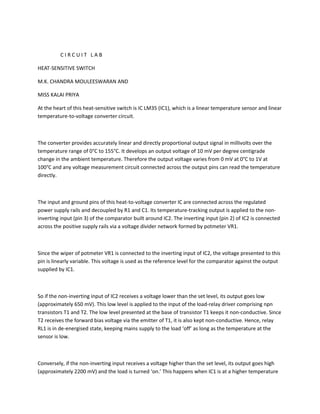
Pro4
- 1. CIRCUIT LAB HEAT-SENSITIVE SWITCH M.K. CHANDRA MOULEESWARAN AND MISS KALAI PRIYA At the heart of this heat-sensitive switch is IC LM35 (IC1), which is a linear temperature sensor and linear temperature-to-voltage converter circuit. The converter provides accurately linear and directly proportional output signal in millivolts over the temperature range of 0°C to 155°C. It develops an output voltage of 10 mV per degree centigrade change in the ambient temperature. Therefore the output voltage varies from 0 mV at 0°C to 1V at 100°C and any voltage measurement circuit connected across the output pins can read the temperature directly. The input and ground pins of this heat-to-voltage converter IC are connected across the regulated power supply rails and decoupled by R1 and C1. Its temperature-tracking output is applied to the non- inverting input (pin 3) of the comparator built around IC2. The inverting input (pin 2) of IC2 is connected across the positive supply rails via a voltage divider network formed by potmeter VR1. Since the wiper of potmeter VR1 is connected to the inverting input of IC2, the voltage presented to this pin is linearly variable. This voltage is used as the reference level for the comparator against the output supplied by IC1. So if the non-inverting input of IC2 receives a voltage lower than the set level, its output goes low (approximately 650 mV). This low level is applied to the input of the load-relay driver comprising npn transistors T1 and T2. The low level presented at the base of transistor T1 keeps it non-conductive. Since T2 receives the forward bias voltage via the emitter of T1, it is also kept non-conductive. Hence, relay RL1 is in de-energised state, keeping mains supply to the load ‘off’ as long as the temperature at the sensor is low. Conversely, if the non-inverting input receives a voltage higher than the set level, its output goes high (approximately 2200 mV) and the load is turned ‘on.’ This happens when IC1 is at a higher temperature